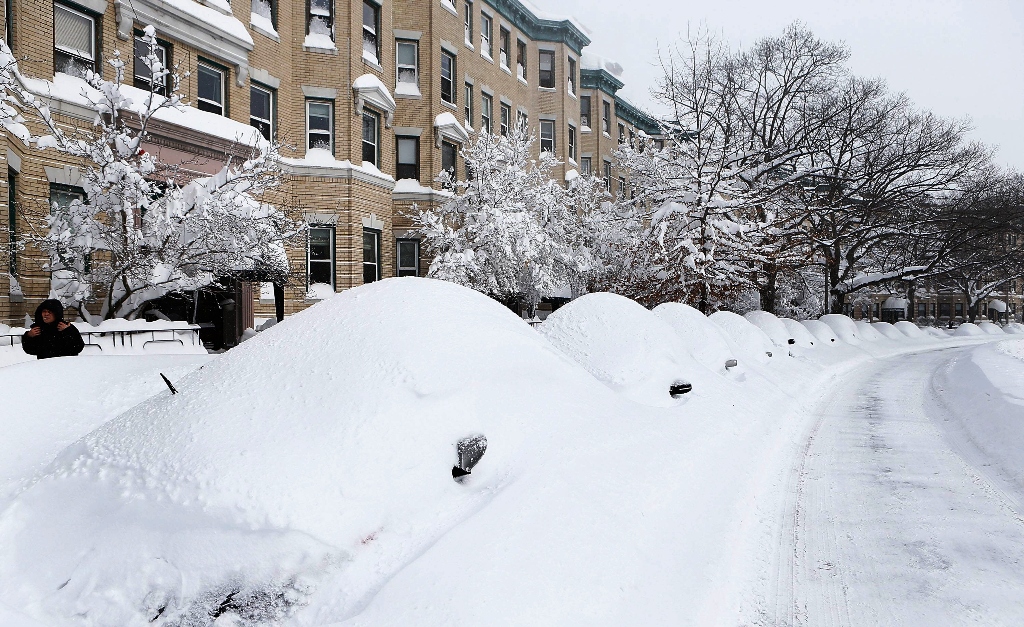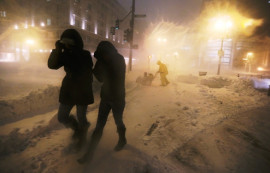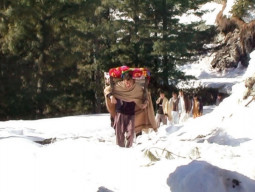
NEW YORK: The US northeast slowly dug out early Sunday from a mammoth blizzard that choked air, road and rail travel, left some 650,000 homes and businesses without power and caused at least seven deaths.
The storm, which hit New York and other areas still scarred by Superstorm Sandy back in October, dumped as much as three feet of snow across New England, with hurricane-strength gusts helping to create massive drifts.
By late Saturday, the system had moved north to Canada, battering three provinces there.
And a new snowstorm was taking aim at the US northern plains, the National Weather Service warned Sunday. "A major winter storm will bring heavy snow and strong winds from northeast Colorado into central Minnesota Sunday into Monday. Snowfall amounts in the hardest hit areas across eastern South Dakota will reach over a foot with 50 mph winds creating whiteout conditions," it said.
New York area airports LaGuardia, John F Kennedy and Newark, which halted all flights during the height of the east coast storm Friday, resumed service with delays. However, FlightAware.com listed almost 2,000 cancellations around the region, on top of the 3,000 plus flights scrapped Friday.
The blizzard engulfing Boston's Logan Airport was so severe that plowing operations were abandoned for several hours overnight. Amtrak said its rail link between New York and Boston would remain closed until Sunday, but trains were resuming normal schedules to Washington.
A driving ban in Massachusetts, where some two feet (0.6 metres) of snow fell in the blizzard and buried Boston streets, was lifted Saturday afternoon.
"We have a lot of snow to dispose of and to remove and it will take some time to do that. That is a necessary prerequisite to getting to power lines and getting power restored," Massachusetts Governor Deval Patrick said.
Connecticut Governor Dannel Malloy lifted a similar ban but urged people to stay home anyway.
"It's critical right now that residents stay off the roads, so that our plows can continue their efforts to clear our streets and highways," Malloy said.
"This is a record setting storm. It's going to take time to dig out of the snow. Stalled or abandoned vehicles will only slow that process. Unless you face an emergency, please stay put."
The 31.9 inches (81 cm) that piled up in Portland, Maine, is the most recorded there from a single snowstorm, officials said.
The Federal Emergency Management Agency (FEMA) said FEMA liaisons have been positioned in state emergency operations centers in Connecticut, Massachusetts, New Hampshire, New Jersey, New York (in Albany and New York City), Rhode Island, and Vermont.
But in New York City, where just under a foot of snow accumulated in Central Park, most roads were cleared by morning.
"Looks like we dodged a bullet," Mayor Michael Bloomberg said.
At midday the sun even came out, as people with sleds flocked to parks and took photographs.
Organisers of New York Fashion Week welcomed the end of the white mess, on the third day of the shows.
"We were in a very white mood... it's a sheer delight!" producer Alexandre de Betak told AFP after the Lacoste show at Lincoln Center.
"It's been three days that we knew it would snow, and we just had to change the planning a bit to get the set up earlier."
With the wind and heavy snow having snapped power lines, more than 650,000 customers lost electricity, including around 400,000 in Massachusetts, 187,000 in Rhode Island, and 35,000 in Connecticut.
Utility companies in Connecticut said they were planning for up to 30 percent of their customers, or more than 400,000 homes, to eventually lose power.
Pilgrim Nuclear Power Station in Plymouth, Massachusetts lost power late Friday and automatically shut down during the snowstorm, according to the Nuclear Regulatory Commission. It was classed an "unusual event," the least severe emergency designation, the statement said.
The severity of the disruption was lessened by the storm's timing at the start of a weekend, but the almost deserted roads across the region were highly dangerous, with the death toll from the storm at seven as of Saturday.
A car driven by a young woman went out of control in the snow on a highway in the town of Poughkeepsie, New York, striking and killing a 74-year-old man who was walking on the shoulder of the road.
In Auburn, New Hampshire, a man was killed after losing control of his car and hitting a tree, local officials said.
And a Massachusetts boy aged 11 died when he and his father were warming up in their car and inhaled carbon monoxide after an exhaust pipe had been blocked by snow.
Four other storm-related deaths were reported in Connecticut.
Minor injuries were reported in a 19-car pileup on Interstate 295 in Falmouth, Maine, caused by poor visibility and slippery road conditions.
The National Weather Service said "travel conditions (on Saturday) will continue to be extremely hazardous, if not impossible."
The storm came a little over three months after Hurricane Sandy devastated swaths of New York and New Jersey, killing 132 people and causing damage worth some $71.4 billion.












































COMMENTS
Comments are moderated and generally will be posted if they are on-topic and not abusive.
For more information, please see our Comments FAQ